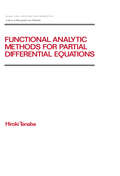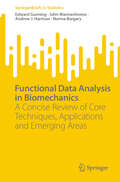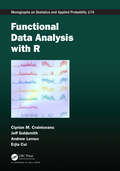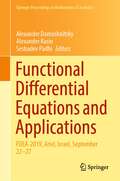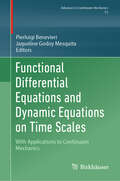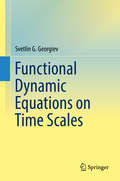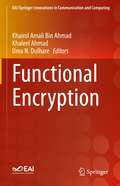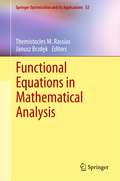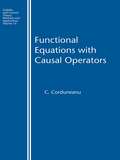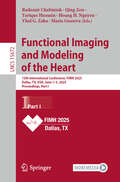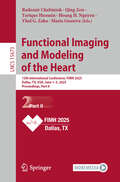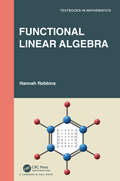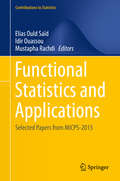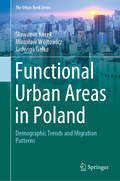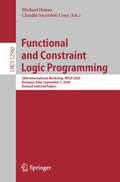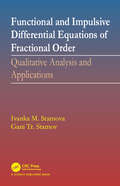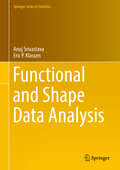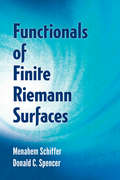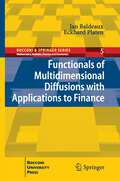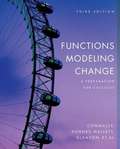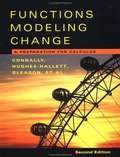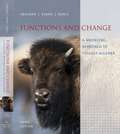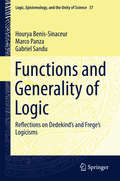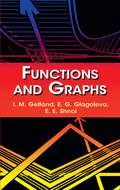- Table View
- List View
Functional Analytic Methods for Partial Differential Equations (Chapman And Hall/crc Pure And Applied Mathematics Ser. #204)
by Hiroki TanabeCombining both classical and current methods of analysis, this text present discussions on the application of functional analytic methods in partial differential equations. It furnishes a simplified, self-contained proof of Agmon-Douglis-Niremberg's Lp-estimates for boundary value problems, using the theory of singular integrals and the Hilbert transform.
Functional Data Analysis in Biomechanics: A Concise Review of Core Techniques, Applications and Emerging Areas (SpringerBriefs in Statistics)
by Edward Gunning John Warmenhoven Andrew J. Harrison Norma BargaryThis book provides a concise discussion of fundamental functional data analysis (FDA) techniques for analysing biomechanical data, along with an up-to-date review of their applications. The core of the book covers smoothing, registration, visualisation, functional principal components analysis and functional regression, framed in the context of the challenges posed by biomechanical data and accompanied by an extensive case study and reproducible examples using R. This book proposes future directions based on recently published methodological advancements in FDA and emerging sources of data in biomechanics. This is a vibrant research area, at the intersection of applied statistics, or more generally, data science, and biomechanics and human movement research. This book serves as both a contextual literature review of FDA applications in biomechanics and as an introduction to FDA techniques for applied researchers. In particular, it provides a valuable resource for biomechanics researchers seeking to broaden or deepen their FDA knowledge.
Functional Data Analysis with R (ISSN)
by Ciprian M. Crainiceanu Jeff Goldsmith Andrew Leroux Erjia CuiEmerging technologies generate data sets of increased size and complexity that require new or updated statistical inferential methods and scalable, reproducible software. These data sets often involve measurements of a continuous underlying process, and benefit from a functional data perspective. Functional Data Analysis with R presents many ideas for handling functional data including dimension reduction techniques, smoothing, functional regression, structured decompositions of curves, and clustering. The idea is for the reader to be able to immediately reproduce the results in the book, implement these methods, and potentially design new methods and software that may be inspired by these approaches.Features: Functional regression models receive a modern treatment that allows extensions to many practical scenarios and development of state-of-the-art software. The connection between functional regression, penalized smoothing, and mixed effects models is used as the cornerstone for inference. Multilevel, longitudinal, and structured functional data are discussed with emphasis on emerging functional data structures. Methods for clustering functional data before and after smoothing are discussed. Multiple new functional data sets with dense and sparse sampling designs from various application areas are presented, including the NHANES linked accelerometry and mortality data, COVID-19 mortality data, CD4 counts data, and the CONTENT child growth study. Step-by-step software implementations are included, along with a supplementary website (www.FunctionalDataAnalysis.com) featuring software, data, and tutorials. More than 100 plots for visualization of functional data are presented. Functional Data Analysis with R is primarily aimed at undergraduate, master's, and PhD students, as well as data scientists and researchers working on functional data analysis. The book can be read at different levels and combines state-of-the-art software, methods, and inference. It can be used for self-learning, teaching, and research, and will particularly appeal to anyone who is interested in practical methods for hands-on, problem-forward functional data analysis. The reader should have some basic coding experience, but expertise in R is not required.
Functional Differential Equations and Applications: FDEA-2019, Ariel, Israel, September 22–27 (Springer Proceedings in Mathematics & Statistics #379)
by Alexander Domoshnitsky Seshadev Padhi Alexander RasinThis book discusses delay and integro-differential equations from the point of view of the theory of functional differential equations. This book is a collection of selected papers presented at the international conference of Functional Differential Equations and Applications (FDEA-2019), 7th in the series, held at Ariel University, Israel, from August 22–27, 2019. Topics covered in the book include classical properties of functional differential equations as oscillation/non-oscillation, representation of solutions, sign properties of Green's matrices, comparison of solutions, stability, control, analysis of boundary value problems, and applications. The primary audience for this book includes specialists on ordinary, partial and functional differential equations, engineers and doctors dealing with modeling, and researchers in areas of mathematics and engineering.
Functional Differential Equations and Dynamic Equations on Time Scales: With Applications to Continuum Mechanics (Advances in Mechanics and Mathematics #52)
by Pierluigi Benevieri Jaqueline Godoy MesquitaThis volume presents recent advances in the field of dynamic equations on time scales and functional differential equations, with a focus on how these topics can be used to describe phenomena in continuum mechanics. Chapters investigate important aspects of these equations, such as asymptotic behavior and the qualitative properties of their solutions. Specific topics covered include: Ulam stability for dynamic equations Generalized ordinary differential equations Singular control systems on time scales Bresse systems Functional Differential Equations and Dynamic Equations on Time Scales will be a valuable resource for graduate students and researchers who work in these areas.
Functional Dynamic Equations on Time Scales
by Svetlin G. GeorgievThis book is devoted to the qualitative theory of functional dynamic equations on time scales, providing an overview of recent developments in the field as well as a foundation to time scales, dynamic systems, and functional dynamic equations. It discusses functional dynamic equations in relation to mathematical physics applications and problems, providing useful tools for investigation for oscillations and nonoscillations of the solutions of functional dynamic equations on time scales. Practice problems are presented throughout the book for use as a graduate-level textbook and as a reference book for specialists of several disciplines, such as mathematics, physics, engineering, and biology.
Functional Encryption (EAI/Springer Innovations in Communication and Computing)
by Khaleel Ahmad Uma N. Dulhare Khairol Amali Bin AhmadThis book provides awareness of methods used for functional encryption in the academic and professional communities. The book covers functional encryption algorithms and its modern applications in developing secure systems via entity authentication, message authentication, software security, cyber security, hardware security, Internet of Thing (IoT), cloud security, smart card technology, CAPTCHA, digital signature, and digital watermarking. This book is organized into fifteen chapters; topics include foundations of functional encryption, impact of group theory in cryptosystems, elliptic curve cryptography, XTR algorithm, pairing based cryptography, NTRU algorithms, ring units, cocks IBE schemes, Boneh-Franklin IBE, Sakai-Kasahara IBE, hierarchical identity based encryption, attribute based Encryption, extensions of IBE and related primitives, and digital signatures.Explains the latest functional encryption algorithms in a simple way with examples;Includes applications of functional encryption in information security, application security, and network security;Relevant to academics, research scholars, software developers, etc.
Functional Equations in Mathematical Analysis
by Themistocles RASSIAS Janusz BrzdekThe stability problem for approximate homomorphisms, or the Ulam stability problem, was posed by S. M. Ulam in the year 1941. The solution of this problem for various classes of equations is an expanding area of research. In particular, the pursuit of solutions to the Hyers-Ulam and Hyers-Ulam-Rassias stability problems for sets of functional equations and ineqalities has led to an outpouring of recent research. This volume, dedicated to S. M. Ulam, presents the most recent results on the solution to Ulam stability problems for various classes of functional equations and inequalities. Comprised of invited contributions from notable researchers and experts, this volume presents several important types of functional equations and inequalities and their applications to problems in mathematical analysis, geometry, physics and applied mathematics. "Functional Equations in Mathematical Analysis" is intended for researchers and students in mathematics, physics, and other computational and applied sciences.
Functional Equations with Causal Operators (Stability And Control Ser. #Vol. 16)
by C. CorduneanuFunctional equations encompass most of the equations used in applied science and engineering: ordinary differential equations, integral equations of the Volterra type, equations with delayed argument, and integro-differential equations of the Volterra type. The basic theory of functional equations includes functional differential equations with cau
Functional Imaging and Modeling of the Heart: 13th International Conference, FIMH 2025, Dallas, TX, USA, June 1–5, 2025, Proceedings, Part I (Lecture Notes in Computer Science #15672)
by Radomír Chabiniok Qing Zou Tarique Hussain Hoang H. Nguyen Vlad G. Zaha Maria GussevaThis two-volume set, LNCS 15672 and LNCS 15673, constitutes the refereed proceedings of the 13th International Conference on Functional Imaging and Modeling of the Heart, FIMH 2025, held in Dallas, Texas, USA, during June 2–4, 2025. The 79 full papers presented in this book were carefully reviewed and selected from 93 submissions. These papers have been organized in the following topical sections:- Part I: Models for Electrophysiology, Arrhythmia and Their Sequalae; Biomechanics and Assessment of Cardiovascular Health; Model-Enhanced Data Acquisition and Processing. Part II: Multiscale & Multimodality Imaging; Image Processing and Visualization; Clinical Translations of Computational Modeling across Medical Specialties.
Functional Imaging and Modeling of the Heart: 13th International Conference, FIMH 2025, Dallas, TX, USA, June 1–5, 2025, Proceedings, Part II (Lecture Notes in Computer Science #15673)
by Radomír Chabiniok Qing Zou Tarique Hussain Hoang H. Nguyen Vlad G. Zaha Maria GussevaThis two-volume set, LNCS 15672 and LNCS 15673, constitutes the refereed proceedings of the 13th International Conference on Functional Imaging and Modeling of the Heart, FIMH 2025, held in Dallas, Texas, USA, during June 2–4, 2025. The 79 full papers presented in this book were carefully reviewed and selected from 93 submissions. These papers have been organized in the following topical sections:- Part I: Models for Electrophysiology, Arrhythmia and Their Sequalae; Biomechanics and Assessment of Cardiovascular Health; Model-Enhanced Data Acquisition and Processing. Part II: Multiscale & Multimodality Imaging; Image Processing and Visualization; Clinical Translations of Computational Modeling across Medical Specialties.
Functional Linear Algebra (Textbooks in Mathematics)
by Hannah RobbinsLinear algebra is an extremely versatile and useful subject. It rewards those who study it with powerful computational tools, lessons about how mathematical theory is built, examples for later study in other classes, and much more. Functional Linear Algebra is a unique text written to address the need for a one-term linear algebra course where students have taken only calculus. It does not assume students have had a proofs course. The text offers the following approaches: More emphasis is placed on the idea of a linear function, which is used to motivate the study of matrices and their operations. This should seem natural to students after the central role of functions in calculus. Row reduction is moved further back in the semester and vector spaces are moved earlier to avoid an artificial feeling of separation between the computational and theoretical aspects of the course. Chapter 0 offers applications from engineering and the sciences to motivate students by revealing how linear algebra is used. Vector spaces are developed over R, but complex vector spaces are discussed in Appendix A.1. Computational techniques are discussed both by hand and using technology. A brief introduction to Mathematica is provided in Appendix A.2. As readers work through this book, it is important to understand the basic ideas, definitions, and computational skills. Plenty of examples and problems are provided to make sure readers can practice until the material is thoroughly grasped. Author Dr. Hannah Robbins is an associate professor of mathematics at Roanoke College, Salem, VA. Formerly a commutative algebraist, she now studies applications of linear algebra and assesses teaching practices in calculus. Outside the office, she enjoys hiking and playing bluegrass bass.
Functional Statistics and Applications
by Elias Ould Saïd Idir Ouassou Mustapha RachdiThis volume, which highlights recent advances in statistical methodology and applications, is divided into two main parts. The first part presents theoretical results on estimation techniques in functional statistics, while the second examines three key areas of application: estimation problems in queuing theory, an application in signal processing, and the copula approach to epidemiologic modelling. The book's peer-reviewed contributions are based on papers originally presented at the Marrakesh International Conference on Probability and Statistics held in December 2013.
Functional Urban Areas in Poland: Demographic Trends and Migration Patterns (The Urban Book Series)
by Sławomir Kurek Mirosław Wójtowicz Jadwiga GałkaThis book explores demographic changes in Functional Urban Areas (FUAs) in Poland since 1990. Functional Urban Areas, introduced by ESPON, refer to functional territorial units that can be defined as travel-to-work-area, representing strong integration between urban cores and their immediate hinterland. The functional urban area consists of a city plus its commuting zone. It fills a significant gap in the academic literature by providing a deep and thorough analysis of the process of population change in Polish FUAs over the past 30 years. In particular, this empirical research work addresses population growth and decline; the main components of population growth including fertility, mortality and migration; age composition; and the pace of population ageing. The book argues that the transformations of urban structures are triggered by second demographic transition (SDT) and suburbanization processes. Based on data from the Central Statistical Office, this comparative study on FUAs in Poland, which employs a division into core and commuting zones, reveals essential similarities and differences in population development, making it possible to construct a demographic typology of FUAs and investigate their spatial arrangements. A unique and innovative book, it will appeal to geographers, demographers, urbanists, city planners and policymakers, as well as students, academic researchers and others involved in urban studies.
Functional and Constraint Logic Programming: 28th International Workshop, WFLP 2020, Bologna, Italy, September 7, 2020, Revised Selected Papers (Lecture Notes in Computer Science #12560)
by Michael Hanus Claudio Sacerdoti CoenThis book constitutes the refereed post-conference proceedings of the 28th International Workshop on Functional and Constraint Logic Programming, WFLP 2020, held in Bologna, Italy, in September 2020.Due to the COVID-19, the workshop was held online. From the 19 full papers submitted, 8 were accepted for presentation at the workshop. The accepted papers cover different programming areas of functional and logic programming, including code generation, verification, and debugging.
Functional and Impulsive Differential Equations of Fractional Order: Qualitative Analysis and Applications
by Ivanka Stamova Gani StamovThe book presents qualitative results for different classes of fractional equations, including fractional functional differential equations, fractional impulsive differential equations, and fractional impulsive functional differential equations, which have not been covered by other books. It manifests different constructive methods by demonstrating how these techniques can be applied to investigate qualitative properties of the solutions of fractional systems. Since many applications have been included, the demonstrated techniques and models can be used in training students in mathematical modeling and in the study and development of fractional-order models.
Functional and Logic Programming: 15th International Symposium, FLOPS 2020, Akita, Japan, September 14–16, 2020, Proceedings (Lecture Notes in Computer Science #12073)
by Keisuke Nakano Konstantinos SagonasThis book constitutes the proceedings of the 15th International Symposium on Functional and Logic Programming, FLOPS 2020, held in Akita, Japan*, in September 2020. The 12 papers presented in this volume were carefully reviewed and selected from 25 submissions. They cover all aspects of the design, semantics, theory, applications, implementations, and teaching of declarative programming focusing on topics such as functional programming, logic programming, declarative programming, constraint programming, formal method, model checking, program transformation, program refinement, and type theory. *The conference was held virtually due to the COVID-19 pandemic.
Functional and Shape Data Analysis
by Anuj Srivastava Eric P. KlassenThis textbook for courses on function data analysis and shape data analysis describes how to define, compare, and mathematically represent shapes, with a focus on statistical modeling and inference. It is aimed at graduate students in analysis in statistics, engineering, applied mathematics, neuroscience, biology, bioinformatics, and other related areas. The interdisciplinary nature of the broad range of ideas covered--from introductory theory to algorithmic implementations and some statistical case studies--is meant to familiarize graduate students with an array of tools that are relevant in developing computational solutions for shape and related analyses. These tools, gleaned from geometry, algebra, statistics, and computational science, are traditionally scattered across different courses, departments, and disciplines; Functional and Shape Data Analysis offers a unified, comprehensive solution by integrating the registration problem into shape analysis, better preparing graduate students for handling future scientific challenges. Recently, a data-driven and application-oriented focus on shape analysis has been trending. This text offers a self-contained treatment of this new generation of methods in shape analysis of curves. Its main focus is shape analysis of functions and curves--in one, two, and higher dimensions--both closed and open. It develops elegant Riemannian frameworks that provide both quantification of shape differences and registration of curves at the same time. Additionally, these methods are used for statistically summarizing given curve data, performing dimension reduction, and modeling observed variability. It is recommended that the reader have a background in calculus, linear algebra, numerical analysis, and computation.
Functionals of Finite Riemann Surfaces
by Menahem Schiffer Donald C. SpencerThis advanced monograph on finite Riemann surfaces, based on the authors' 1949-50 lectures at Princeton University, remains a fundamental book for graduate students. Suitable for graduate-level courses, the text begins with three chapters that offer a development of the classical theory along historical lines, examining geometrical and physical considerations, existence theorems for finite Riemann surfaces, and relations between differentials. Subsequent chapters explore bilinear differentials, surfaces imbedded in a given surface, integral operators, and variations of surfaces and of their functionals. The book concludes with a look at applications of the variational method and remarks on generalization to higher dimensional Kahler manifolds.
Functionals of Multidimensional Diffusions with Applications to Finance
by Eckhard Platen Jan BaldeauxThis research monograph provides an introduction to tractable multidimensional diffusion models, where transition densities, Laplace transforms, Fourier transforms, fundamental solutions or functionals can be obtained in explicit form. The book also provides an introduction to the use of Lie symmetry group methods for diffusions, which allows to compute a wide range of functionals. Besides the well-known methodology on affine diffusions it presents a novel approach to affine processes with applications in finance. Numerical methods, including Monte Carlo and quadrature methods, are discussed together with supporting material on stochastic processes. Applications in finance, for instance, on credit risk and credit valuation adjustment are included in the book. The functionals of multidimensional diffusions analyzed in this book are significant for many areas of application beyond finance. The book is aimed at a wide readership, and develops an intuitive and rigorous understanding of the mathematics underlying the derivation of explicit formulas for functionals of multidimensional diffusions.
Functions Modeling Change: A Preparation For Calculus
by Eric Connally Deborah Hughes-Hallett Andrew M. GleasonThe third edition of this ground-breaking text continues the authors' goal - a targeted introduction to precalculus that carefully balances concepts with procedures. Overall, this text is designed to provide a solid foundation to precalculus that focuses on a small number of key topics thereby emphasizing depth of understanding rather than breath of coverage. Developed by the Calculus Consortium, FMC 3e is flexible enough to be thought-provoking for well-prepared students while still remaining accessible to students with weaker backgrounds. As multiple representations encourage students to reflect on the material, each function is presented symbolically, numerically, graphically and verbally (the Rule of Four). Additionally, a large number of real-world applications, examples and problems enable students to create mathematical models that will help them understand and interpret the world in which they live.
Functions Modeling Change: A Preparation for Calculus (2nd Edition)
by Eric Connally Elliot J. Marks Jerry Morris Karen Rhea Pat Shure Carl Swenson Katherine Yoshiwara Deborah Hughes-Hallett Frank Avenoso Philip Cheifetz Ann Davidian Daniel E. Flath Andrew M. Gleason Brigitte Lahme Patti Frazer LockThis is a new edition of the precalculus text developed by the Consortium based at Harvard University and funded by a National Science Foundation Grant. The text is thought-provoking for well-prepared students while still accessible to students with weaker backgrounds. It provides numerical and graphical approaches as well as algebraic approaches to give students another way of mastering the material. This approach encourages students to persist, thereby lowering failure rates. A large number of real-world examples and problems enable students to create mathematical models that will help them understand the world in which they live. The focus is on those topics that are essential to the study of calculus and these topics are treated in depth. Linear, exponential, power, and periodic functions are introduced before polynomial and rational functions to take advantage of their use to model physical phenomena. Building on the Consortium's Rule of Four: Each function is represented symbolically, numerically, graphically, and verbally where appropriate.
Functions and Change: A Modeling Approach to College Algebra (3rd Edition)
by Bruce Crauder Benny Evans Alan NoellThis edition provides an alternative to a traditional college algebra course for students who either will not take another math course or may go on to a business calculus course. An informal approach offers clear explanations that leave out unnecessary technicalities so that students who are not comfortable with algebra will easily understand the concepts.
Functions and Generality of Logic
by Hourya Benis-Sinaceur Marco Panza Gabriel SanduThis book examines three connected aspects of Frege's logicism: the differences between Dedekind's and Frege's interpretation of the term 'logic' and related terms and reflects on Frege's notion of function, comparing its understanding and the role it played in Frege's and Lagrange's foundational programs. It concludes with an examination of the notion of arbitrary function, taking into account Frege's, Ramsey's and Russell's view on the subject. Composed of three chapters, this book sheds light on important aspects of Dedekind's and Frege's logicisms. The first chapter explains how, although he shares Frege's aim at substituting logical standards of rigor to intuitive imports from spatio-temporal experience into the deductive presentation of arithmetic, Dedekind had a different goal and used or invented different tools. The chapter highlights basic dissimilarities between Dedekind's and Frege's actual ways of doing and thinking. The second chapter reflects on Frege's notion of a function, in comparison with the notions endorsed by Lagrange and the followers of the program of arithmetization of analysis. It remarks that the foundational programs pursued by Lagrange and Frege are crucially different and based on a different idea of what the foundations of mathematics should be like. However, despite this contrast, the notion of function plays similar roles in the two programs, and this chapter emphasizes the similarities. The third chapter traces the development of thinking about Frege's program in the foundations of mathematics, and includes comparisons of Frege's, Russell's and Ramsey's views. The chapter discusses earlier papers written by Hintikka, Sandu, Demopoulos and Trueman. Although the chapter's main focus is on the notion of arbitrary correlation, it starts out by discussing some aspects of the connection between this notion and Dedekind Theorem.
Functions and Graphs
by I. M. Gelfand E. E. Shnol E. G. GlagolevaThe second in a series of systematic studies by a celebrated mathematician I. M. Gelfand and colleagues, this volume presents students with a well-illustrated sequence of problems and exercises designed to illuminate the properties of functions and graphs. Since readers do not have the benefit of a blackboard on which a teacher constructs a graph, the authors abandoned the customary use of diagrams in which only the final form of the graph appears; instead, the book's margins feature step-by-step diagrams for the complete construction of each graph. The first part of the book employs simple functions to analyze the fundamental methods of constructing graphs. The second half deals with more complicated and refined questions concerning linear functions, quadratic trinomials, linear fractional functions, power functions, and rational functions.
